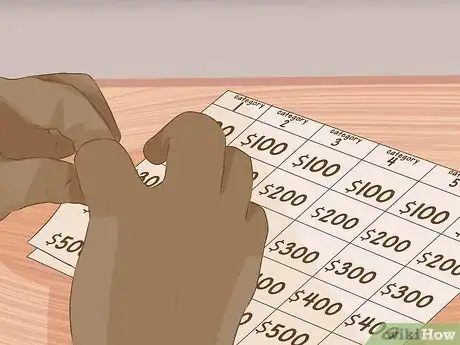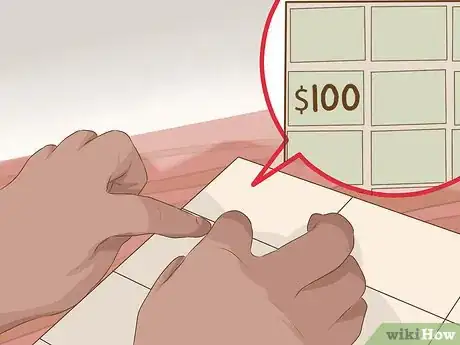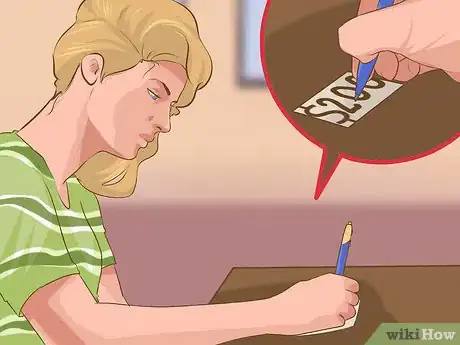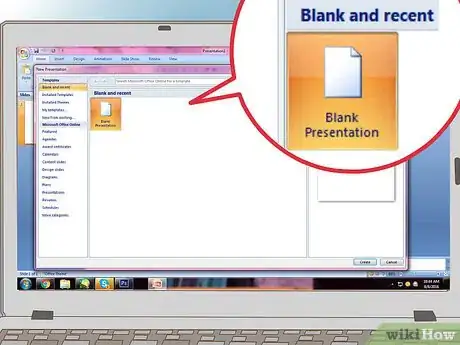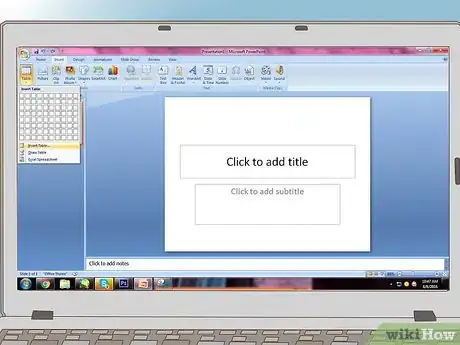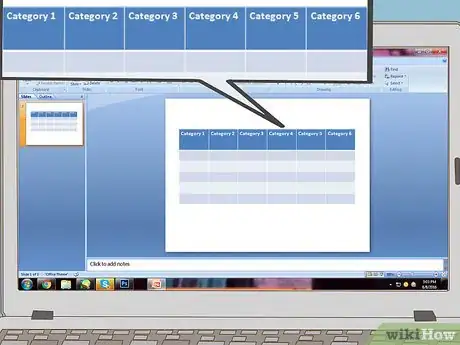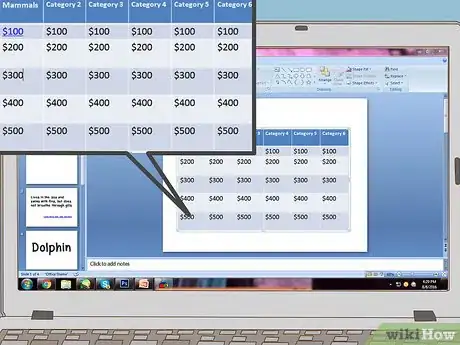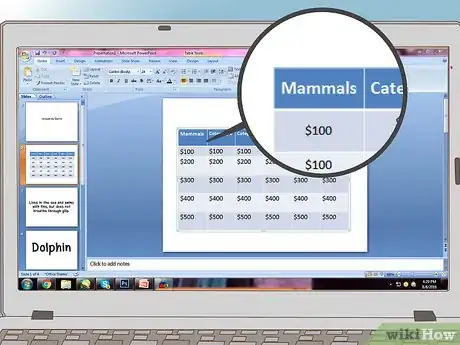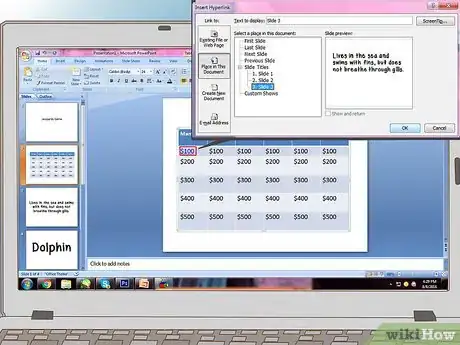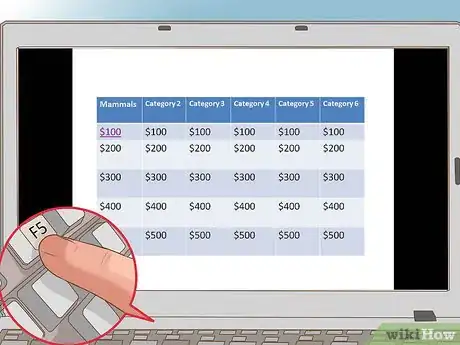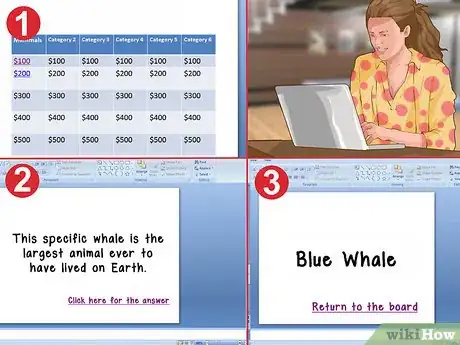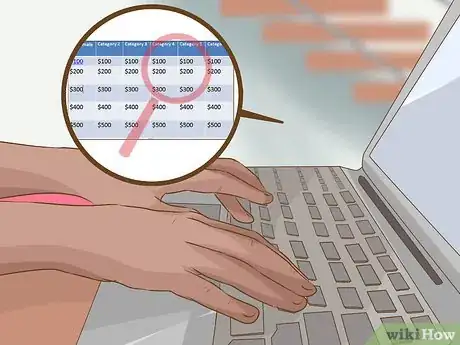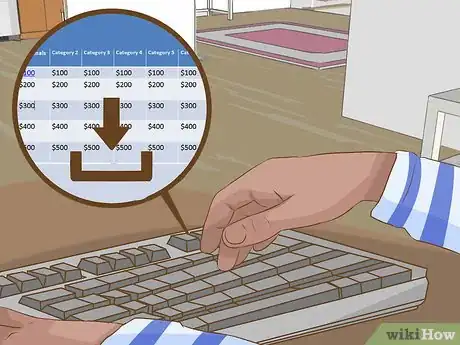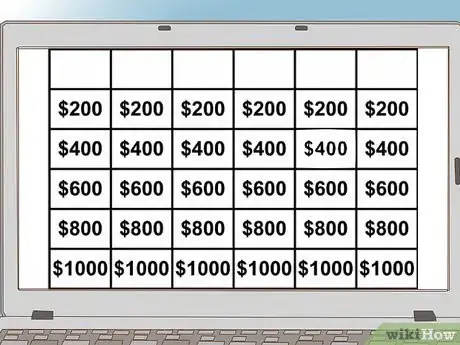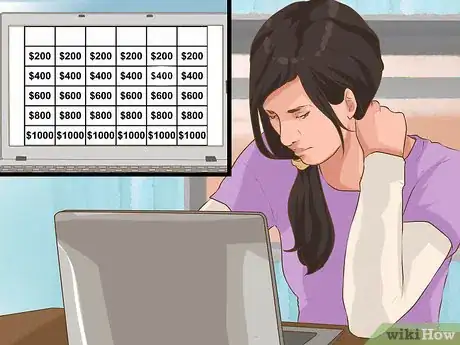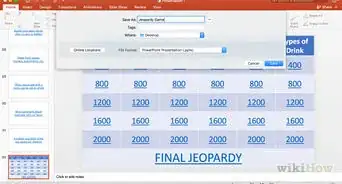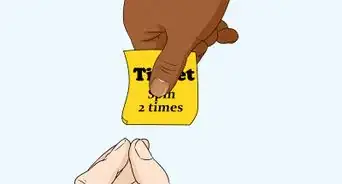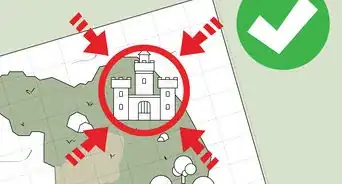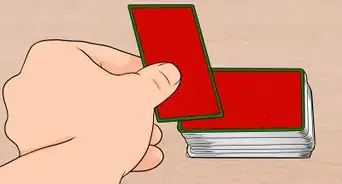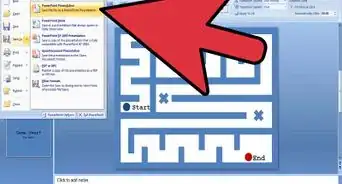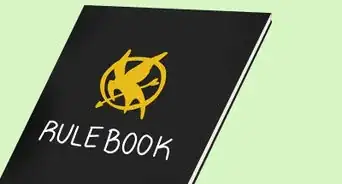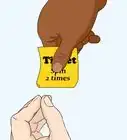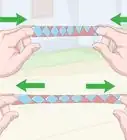This article was co-authored by wikiHow staff writer, Amber Crain. Amber Crain has been a member of wikiHow’s writing staff for the last six years. She graduated from the University of Houston where she majored in Classical Studies and minored in Painting. Before coming to wikiHow, she worked in a variety of industries including marketing, education, and music journalism. She's been a radio DJ for 10+ years and currently DJs a biweekly music program on the award-winning internet radio station DKFM. Her work at wikiHow supports her lifelong passion for learning and her belief that knowledge belongs to anyone who desires to seek it.
This article has been viewed 156,663 times.
Learn more...
Making your own Jeopardy game is a great way for students to learn course material in a fun way, and game enthusiasts love playing it recreationally. Making your own game means that you can customize the clues and answers in any way that you see fit, adjusting the skill level and categories as needed. Whether you’re looking for an enjoyable way to study for exams or if you just want something new for game night, making your own Jeopardy game is a great solution.
Steps
Making a Game with Index Cards
-
1Choose the 6 game categories and decide who will play the host. If you’re playing this Jeopardy game as a way to study for your classes, use your school texts and notes to decide what the categories should be. Choose the major themes from the chapters that your upcoming exam will cover, for example.
- If this is a recreational game, you can either decide on the categories as a group, or the host alone can choose them.
- Whoever is playing the host of this round will be completing the rest of these steps.
-
2Get 6 index cards for the game categories. Write one category on each index card and pin those 6 index cards at the top of a sturdy piece of poster board. Line them up in a single row. Make sure to write legibly (or type and print out the text, if you prefer).
- You can also use a marker board if you don’t have poster board on hand.[1]
- Write the 6 categories at the top of the marker board and draw lines between them to separate the columns.
Advertisement -
3Take 5 more index cards and label them with point values. The point values range from $100 to $500 in each category, so you will have one card for each of these values – $100, $200, $300, $400 and $500.
- Be sure to write legibly, or you could type and print it out if you want it to look extra nice.
-
4Turn over the $100 index card and write your first clue for Category 1 on the back. The $100 question should be the easiest one. For instance, if your first category is “Code Names” you could write something like, “James Bonds’ Agent number.” As the host, you’ll need to create a list with all of the answers on a separate sheet of paper. In this case the answer would be, “What is 007?”
- Remember, in Jeopardy contestants are given the answer (the clue) and their response should be in question form.
- Only the host should work on the answer key.
-
5Pin the $100 card directly beneath the category it goes with. Make sure to pin the card so that the $100 side is facing out. Before you pin the card up, you may want to write $100 on the board first, then pin the card over that.
- When the host pulls the card from the board to read the clue, the spot will be empty but the point value will stay on the board.
- Once you get pretty far along in the game, this will help to give the board a little structure.
-
6Turn over the $200 index card and write down the next clue. You will follow the same process as before. Remember, the higher the point value, the harder the question should be, so increase the difficulty for this next clue/answer.[2]
- Pin the $200 card directly beneath the $100 card in Category 1.
- The cards will go in ascending order, starting with $100 at the top of the column, and ending with $500 at the bottom.
- Make sure to pin the card so that the $200 side is facing out. This will be the practice for all of the clue/answer cards.
-
7Continue the process for the remaining point values in Category 1. Then follow the same procedure for the rest of the game board until all of the categories have completed index cards pinned up. At this point, the game is ready to play.
Creating a Game in Power Point
-
1Open PowerPoint and click Blank Presentation. This will take you to a blank slide. Title the slide “Jeopardy Game” (or any other title you want). You can also use this space to create a welcome message, insert images, etc. This is the first slide everyone will see during game play.[3]
- To give your slides a little pizzazz, go up to the Design tab and choose from the many Themes listed.
- You can even customize each Theme with your own colors and fonts, if you wish.
-
2Add your first slide to your presentation. Click New Slide. This will bring up the next blank slide. Go up to the Insert tab and then click Table. A dropdown menu will appear. Click Insert Table. A pop-up will appear, asking you to choose how many columns and rows you want. Choose 5 for Columns and 6 for Rows. The table will be 5 x 6. Then click OK.[4]
- Drag the corners of the table to resize the cells so that the game board fills up the entire slide.
- If you would like to change the color scheme of your table, go up to the Table Tools section of the menu bar and select Design. Choose from the color options presented.
-
3Use the top row of cells to create categories. Click the top left cell and a cursor will appear. Type Category 1 in the box and then hit Tab to move to the next cell in the top row. Type Category 2 into this box. Hit tab again and type Category 3 into this box. Continue the same procedure until the top row has been completed with a Category 4, Category 5 and Category 6.[5]
- If you’d like to customize any of the text, highlight it and hit the Home tab. From here you can change font type, size, and color.
- You can also align the text to be in the center of each box, if you prefer.
-
4Fill in the rest of the cells with game points. Click on the box directly beneath Category 1. A cursor appears. Type in $100. Click on the box right beneath that. Type in $200. Follow the same procedure for the remaining 2 boxes in that column, so that you have a box for $300, $400 and $500.[6] Do the exact same thing in the columns for Categories 2 – 6.
- Each column should start at the top with the $100 box appearing directly below the Category box, and then end at the bottom with the $500 box.
- To customize the text in these boxes, just highlight it and hit the Home tab.
- You will definitely need to go up to a minimum font size of 48 to ensure visibility.
- If you centered the text in your Category boxes, you should do the same for the remaining cells in the table for consistency.
-
5Change the text in the Category 1 box to reflect the topic you’ll be using. Now that your board is shaping up, it’s time to start customizing it. Highlight the text in the box that says Category 1, delete it, and then type in what topic you plan to use for your game.
- For instance, If your topic first topic is “Mammals,” type that word in the box to replace the generic “Category 1” that was previously there.
- Adjust the font up or down as needed so that your topic fits in the box.
-
6Add another new slide to your presentation. This will be Slide 3. On slide 3, type out the clue that belongs to the $100 question in Category 1. If you were typing a $100 clue for the topic of “Mammals,” you would type something like: “Lives in the sea and swims with fins, but does not breathe through gills.”
- Highlight the text and hit the Home tab to customize your text.
- Make it larger, change the font or the text color, center text – make it look however you want.
-
7Highlight $100 in the Category 1 column. Right click on the highlighted text and select Hyperlink from the menu that appears. Click Place in This Document, which will be on the left side of the box that appears. Then you will select Slide 3 and hit OK. Now your $100 question under the topic “Mammals” is linked to Slide 3, which features the clue.[7]
- To test the feature, hit F5 for slideshow view. Slide 1 will appear first. Hit the right arrow key to go to Slide 2. This is your game board so far.
- Click the $100 link under “Mammals” and it will take you directly to Slide 3, which is the corresponding clue.
- Hit Esc to take you back to the slides in Edit view.
-
8Add another new slide to your presentation. This will be Slide 4. On slide 4, type out the answer that belongs to the $100 clue in “Mammals,” which is “Dolphin.” Click back to Slide 3. In the bottom right corner, create a text box and type “Click here for the answer.” Highlight that text, right click, and select Hyperlink.
- Choose Place in This Document, and then select Slide 4.
- Now your $100 clue under the topic “Mammals” is linked to Slide 4, which features the answer.
-
9Test the feature by hitting F5 for slideshow view. Hit the right arrow key button to go to Slide 2. Click the $100 link under “Mammals” and it will take you directly to Slide 3, which is the corresponding clue: “Lives in the sea and swims with fins, but does not breathe through gills.”
- Click the link the link that you just created on the bottom right of Slide 3, which takes you directly to the corresponding answer on Slide 4: “What is a dolphin?”
- Hit Esc to take you back to the slides in Edit view.
-
10Go back to Slide 4 and insert a Text Box at bottom right. Type in “Return to the board.” Highlight this text, right click, then choose Hyperlink. Hit Place in This Document and select Slide 2, which is your game board. Then click OK. Now your answer slide is directly linked back to the board, so when you’re finished with the $100 clue and answer for “Mammals” you can navigate easily back.
- If you want to test it out, hit F5 and go through the clue and answer, test the links, and then hit the link to go back to the game board.
- Every answer slide you create in this presentation will need the “Return to the board” link at bottom right, just like this one.
-
11Click the $200 box under the “Mammals” category. You’re ready to input your next clue and answer. The procedure is exactly the same. Add a new slide (which will be Slide 5), type the next clue on that slide, highlight $200 on the board, right click and hyperlink to Slide 5. Type “Click here for the answer” at the bottom right of Slide 5.
- Then add Slide 6. Type the answer to the clue on Slide 6. Highlight “Click here for the answer” on Slide 5, right click, choose Hyperlink and then choose Slide 6 to link them together.
- Type “Return to the board” at the bottom right on Slide 6, highlight the text, right click, Hyperlink, and select Slide 2 to create a link back to the game board.
-
12Continue the process until all of the clues and answers are entered. Hit F5 to go to slideshow view, and then go through each Category clue and answer to make sure all of your links work.[8] Feel free to jazz up your slides with additional content, images, etc.
- Your slideshow Jeopardy game can be as simple and bare bones as you like, or you can get really creative with it.
Using Online Jeopardy Templates
-
1Search online for “jeopardy templates.” You will get pages and pages of hits. There are templates that are fully customizable and some that will generate the clues/answers for you. You can download game templates for PowerPoint, Google docs, Microsoft Excel, or use one that a gaming website provides.[9]
- These templates range from very simple to fairly elaborate. Do a little exploring to see what is out there.
- You can also play Jeopardy games directly through some of the gaming websites, no downloading required.
-
2Choose and download a template to your device. After you’ve found a Jeopardy template that you like, download it to your computer, mobile phone or tablet. Some template websites offer versions for all possible devices, while others cater to a specific device type.
- These template files are not large, so download a few different ones that interest you.
- You can experiment with several until you find the right fit.
-
3Open the template file and follow the prompts to set up the game. If you’re filling in all of the data yourself, start compiling your clues/answers. The template will likely walk you through set up, and each one is a little different.[10]
- If you’re playing this game as a way to study for a class, use your school texts and notes to decide what the categories should be.
- Select major themes or topics from textbook chapters to help you study for exams.
- If this is a recreational game, you can decide on the categories as a group or devise some other way to come up with them.
-
4Plug all of the required data into your template (if required). Remember, the higher the point value, the harder the question should be, so increase the difficulty as the point value gets larger in each category.[11] If you need to memorize vocabulary words, use those as your answers.
- The clues will be the definitions of the corresponding vocabulary words.
- Once the template is completely filled out, the game is ready to play.
References
- ↑ https://tekhnologic.wordpress.com/2016/01/06/5-ways-to-play-jeopardy/#ppt
- ↑ https://tekhnologic.wordpress.com/2016/01/06/5-ways-to-play-jeopardy/#ppt
- ↑ http://www.duluth.umn.edu/~hrallis/guides/PP/pp_jeopardy/jeopardy.html
- ↑ http://www.duluth.umn.edu/~hrallis/guides/PP/pp_jeopardy/jeopardy.html
- ↑ http://www.duluth.umn.edu/~hrallis/guides/PP/pp_jeopardy/jeopardy.html
- ↑ http://www.duluth.umn.edu/~hrallis/guides/PP/pp_jeopardy/jeopardy.html
- ↑ http://www.duluth.umn.edu/~hrallis/guides/PP/pp_jeopardy/jeopardy.html
- ↑ http://www.duluth.umn.edu/~hrallis/guides/PP/pp_jeopardy/jeopardy.html
- ↑ https://docs.google.com/presentation/d/1N_5IbXUY3y2PCuhFQ0YA7ZuREwC7ew1Q3fyILBnEBQA/edit#slide=id.g2af4f3288_00
Community Q&A
-
QuestionIs there a list option with questions and answers?
 Community AnswerSome of the downloadable templates will plug in clues/answer for you, but in most cases you'll need to create them. If you want to play Jeopardy through a website, the clues/answers are provided.
Community AnswerSome of the downloadable templates will plug in clues/answer for you, but in most cases you'll need to create them. If you want to play Jeopardy through a website, the clues/answers are provided.
About This Article
The easiest way to make a Jeopardy game is to find a template online and fill it in. If you prefer to set up your game using Power Point, open a blank presentation and create a table that has 5 columns and 6 rows. Use the top row of cells to create categories, like “Mammals,” and fill in the rest of the cells with game points, like “$100.” Then, on the remaining slides, type the clues for the questions and hyperlink them to the squares with the points. To learn how to make a Jeopardy game with index cards, keep reading!


